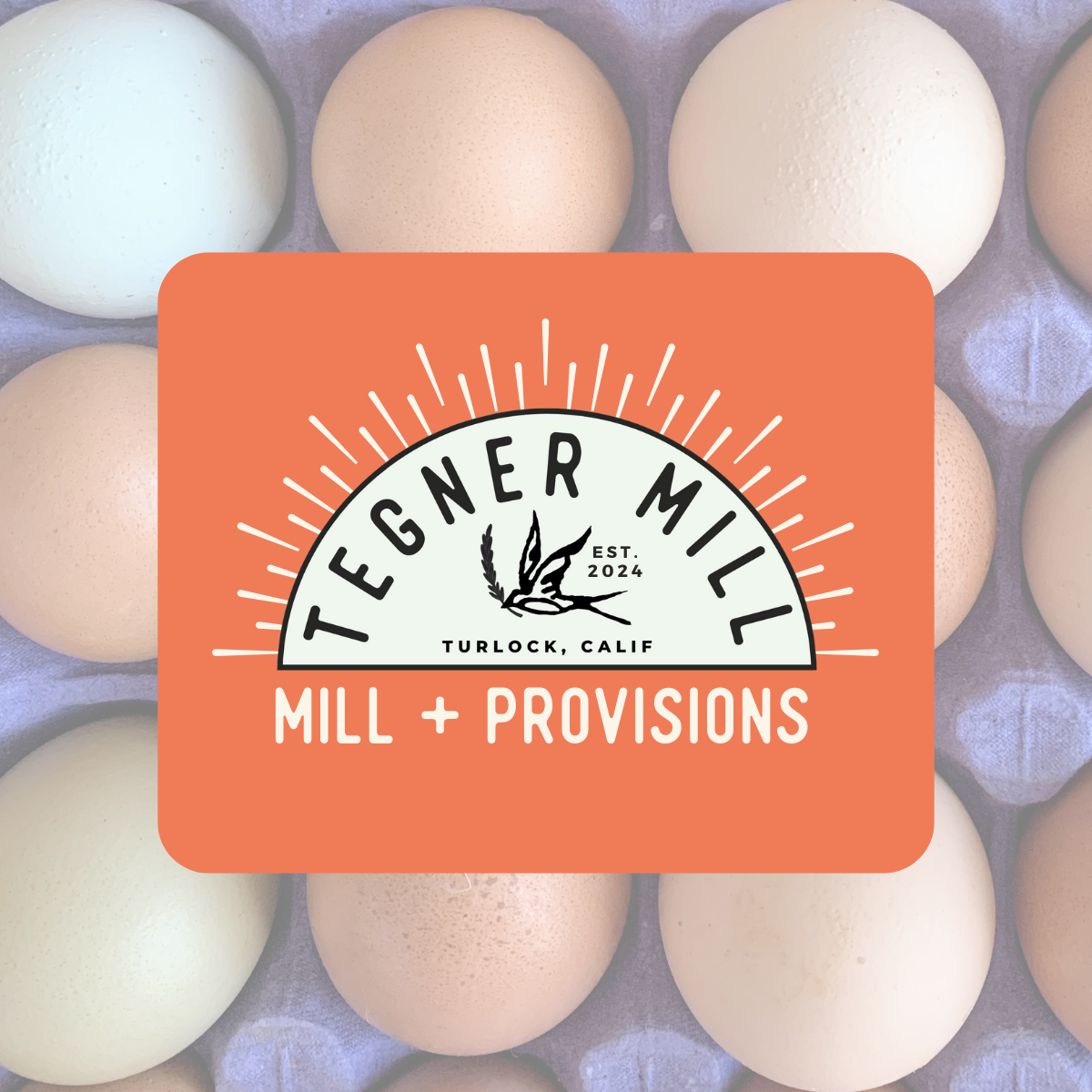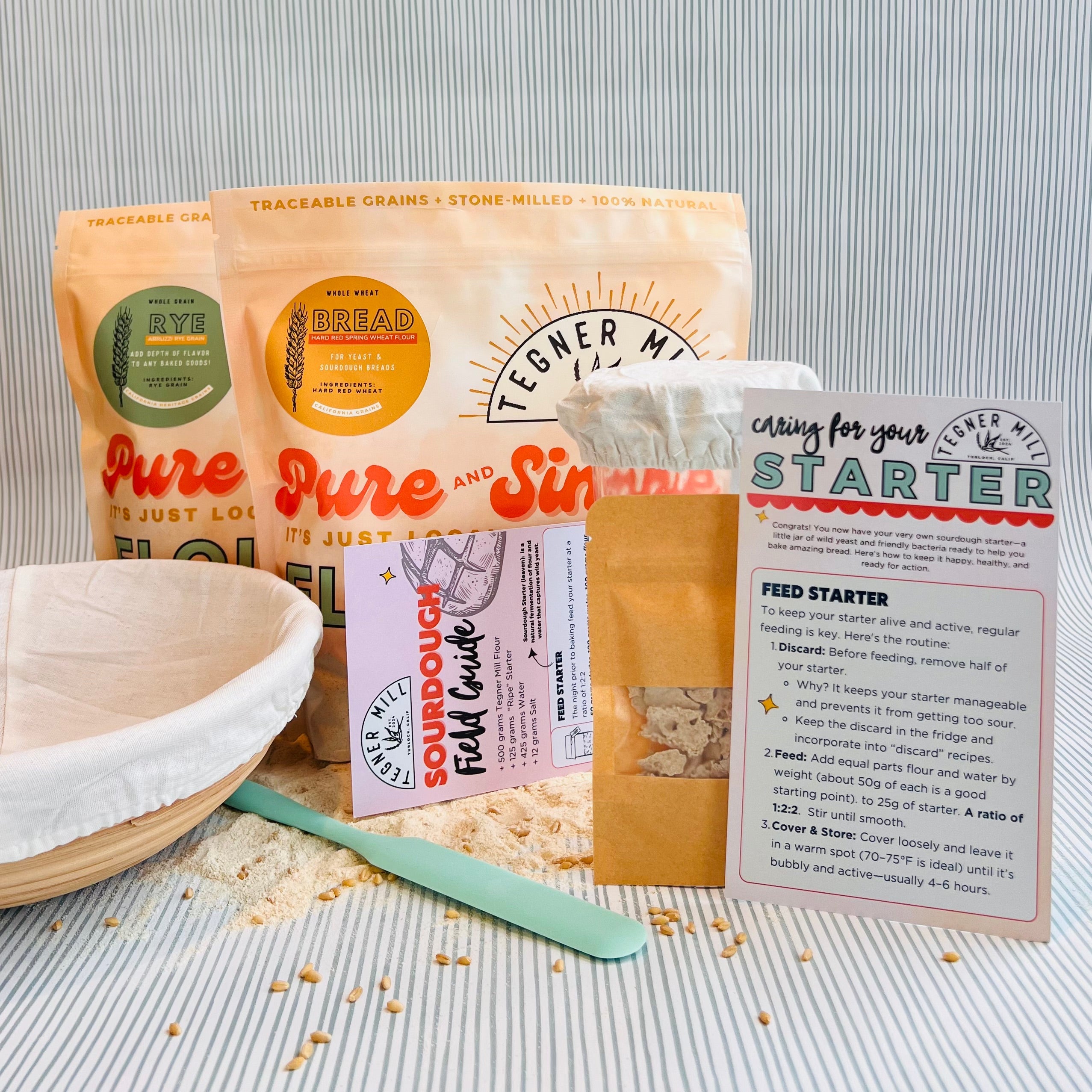Beginner friendly whole wheat sourdough bread with Tegner Mill’s Whole Wheat Bread Flour. A simple, flavorful boule that highlights the rich taste of our fresh, stone-milled flour.
Ingredients
Example Product Title
Regular price
Unit price
per
Instructions
Feed Starter
- Approx. 4- 13 hours before you start mixing, combine:
- 150 grams starter
- 120 grams water
- 200 grams Tegner Mill Flour
- Mix everything well in a jar or bowl, then cover with plastic wrap or a cloth. Let it sit at room temperature to ferment until bubbly and active. This should be a fairly stiff starter.
Mix Dough
- In a large bowl, measure your water (leave out 25g if you want to dissolve the salt later) and add 100g of your active starter. Stir well to break up and dissolve the starter.
- Add the flour and mix thoroughly with your hands until all the flour is hydrated. The dough will feel shaggy and sticky—this is normal!
- If you’ve set aside 25g of water, mix it with the salt in a small bowl to dissolve, then set it aside for later.
- Use a dough scraper or stiff spatula to clean the sides of the bowl and your hands.
- Cover the bowl with plastic wrap or towel and let the dough rest for 1 hour. This rest period, called autolyse, allows the flour to absorb the water fully.
Stretch & Fold
- Add the Salt: Sprinkle the salt over the dough (and any reserved salt water, if applicable). Mix thoroughly with your hands until the salt is fully incorporated. Cover the bowl with plastic wrap or a damp towel.
- Stretch and Fold: Instead of kneading, use the stretch and fold method:
- Grab one side of the dough, lift it up about 6 inches, and fold it over the rest of the dough.
- Turn the bowl a quarter turn and repeat. Do this 3–4 times for one round.
- Perform 3 stretch and fold rounds, one every 30 minutes for the first 1 ½ hours.
- After each round, cover the dough and let it rest.
- With each round, you’ll notice the dough gaining strength and becoming harder to stretch. Be firm but gentle—stretch as far as it allows without tearing.
Bulk Ferment
- Cover with plastic wrap and allow the dough to bulk ferment in a warm place until doubled. This can take anywhere between 1-8 hours.
Shape & Cold Proof
- Prepare the Dough: Lightly flour your work surface and turn out the dough.
- If you’re making one loaf, you can skip the bench rest. If doubling or tripling the recipe, divide the dough, do a rough pre-shape (lightly tighten it into a round), and let it rest for 15 minutes.
- Final Shaping: Shape the dough into a smooth ball by gently spinning it toward you on the countertop to create surface tension. This tension helps the loaf hold its shape and rise better.
- Prepare the Proofing Basket or Bowl: If using a proofing basket (banneton), lightly flour it. If using a regular bowl, line it with a flour sack towel or linen, dusted generously with flour to prevent sticking.
- Transfer the Dough: Place the shaped dough, seam side up, into the banneton or bowl.
-
Cold Proof: Cover the dough with plastic wrap and then into a bag tied. Refrigerate for 12–14 hours. This cold proof allows the dough to develop flavor and structure overnight.
Bake Your Bread
- Preheat the Oven: 45–60 minutes before baking, place a Dutch oven (or cast iron bread pan) in your oven and preheat to 500°F.
- Prepare the Dough: Remove your dough from the fridge and place it on a piece of parchment paper for easier handling.
- Lightly dust the top with flour if you want to highlight your scoring pattern (optional).
- Score the top of the dough using a lame or razor blade.
- Bake with the Lid On: Carefully remove the preheated Dutch oven from the oven. Gently lower the parchment paper and dough into the hot pot.
- Cover with the lid and return to the oven.
- Bake at 500°F for 30 minutes.
- Finish Baking: Reduce the oven temperature to 450°F and continue baking for 8–10 minutes with the lid still on.
- If needed, remove the lid for the final few minutes to darken the crust further. The crust should be deeply colored, and the loaf should sound hollow when tapped on the bottom.
- Check for Doneness: The internal temperature of the bread should be around 208°F. If it’s not fully baked, you can leave it in for a few more minutes uncovered.
- Cool Completely: Let the loaf cool fully on a wire rack before slicing. Cutting too soon will result in a gummy crumb.





